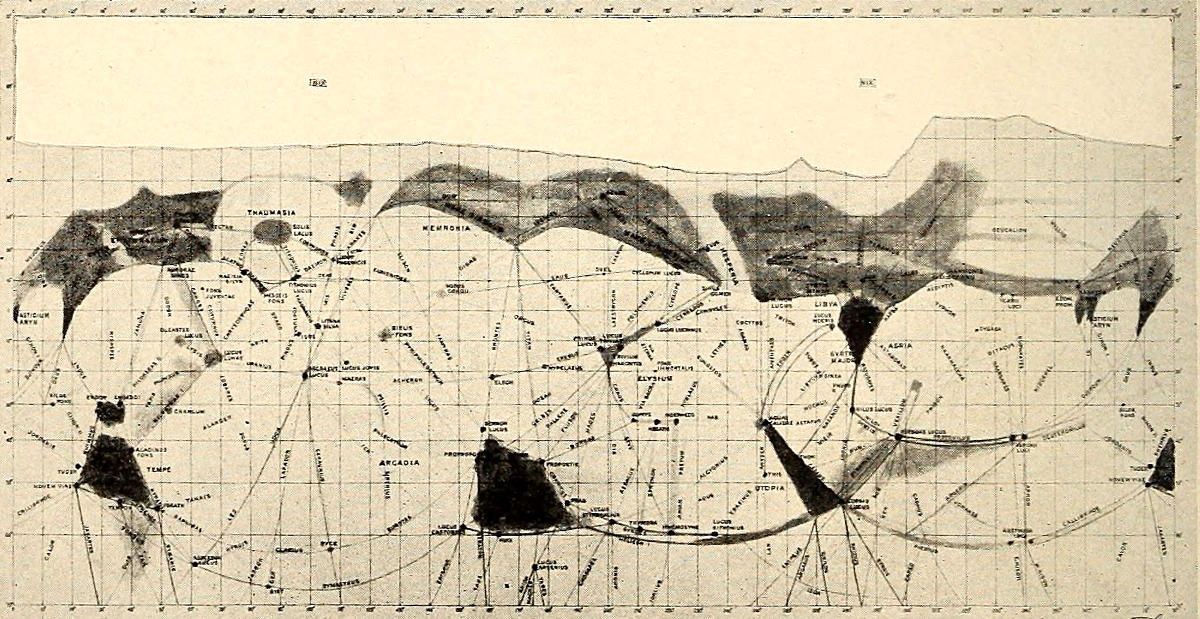Article

Life beyond our planet by Dan Q. Posin
Could the planet mars be one of the Divinas, one of the planets with advanced life?
Chicago Tribune, June 7, 1964
Mars turns on its axis, making one complete turn in about 24 1/2 hours. It is about 141.5 million miles from the sun [the earth is 93 million miles away], and a Martian year is the length of 1.886 earth years.
For 20 years, Percival Lowell had one abiding passion--the planet Mars. He studied it as no other earthling ever had, and although he has been dead for nearly a half century, much of our present knowledge of the "red planet" comes from his findings. The American astronomer Percival Lowell E1855-19161 firmly believed that there were canals on Mars that had been constructed by superior beings. Lowell put in more than 20 years in- studying Mars. His findings, however, were generally not believed by other astronomers. Lowell was daring, bold, and outspoken.
His observations formed the basis for his books: Mars, then Mars and Its Canals, Mars as the Abode of Life, The Evolution of Worlds, The Solar System, and The Genesis of the Planet. "Conditions may exist there under which our wildest fancies may be commonplace facts," he wrote.
Incidentally, Percival Lowell spent six years making calculations concerning irregularities in the motion of the planet Neptune. He came to the conclusion that there must be a planet beyond, which was pulling upon Neptune. Lowell died in 1916. In 1930, in a search made at the observatory he had founded, a discovery was made of a planet beyond Neptune. This planet we now know as Pluto. [It was a 13-year-old British girl who, in a letter written to the Lowell Observatory, made the suggestion that the planet be named Pluto, because the first two letters would remind the world of Percival Lowell.
Mars rotating once in about 24 1/2 Hours
About 100 years before, British astronomer J. C. Adams and the French- man U. J. J. Leverrier had made calculations about the strange behavior of Uranus, predicting a planet beyond it, and this prediction led to the discovery of Neptune itself. Yet, don't think it was easy for Adams and Leverrier to get action or to generate confidence in their calculations. Percival Lowell studied Mars thru his telescopes as tho half of his soul roamed over the surface of that planet. He said: "There are canals on Mars. They were built by intelligent beings for irrigation purposes-to conduct the melting polar ice and snow to the more arid regions on Mars."
He studied these canals as Mars turned on its axis, and he drew hundreds of sketches as he watched, and he painted the various regions in the colors that he saw. He made one amazing sketch of the canals that is a composite of looks from all sides, with the Mar- tian north pole as the point immediately below us, as if we were gazing directly down upon it.
Why would Martians need to construct canals? Why would there be a shortage of water?
Lowell pointed to the fact that Mars is a much smaller planet than earth, only 4,200 miles in diameter, while earth is almost 8,000. If the two planets were created as hot bodies at the same time, Mars would have cooled off much faster than did earth. Accordingly, Mars would have reached a reasonable temperature, favorable to the support of life, millions of years earlier than earth did.
Thus, Mars would have come into its own early in the game, and would have produced its intelligent beings, who went on to super-intelligence long before earth- lings came to gaze with awe at the heavens.
Yet, why, then, would Martians have built canals? Lowell explained that if Mars had an ample supply of water once upon a time, this supply would have tended to escape from the planet. The gravity on Mars is only 38 per cent of that on earth. Consequently, when water on Mars evaporated, its molecules could move fast enough to escape completely from the planet surface, whereas, on earth, the water molecules would be slowed enough by the gravitational pull- back, would join with others in the cooler temperatures at great heights, and finally come dropping back to earth as rain.
In order to conserve their dwindling water supply, Lowell said, the Martians had to devise great planet-wide engineering feats that would make the Panama canal seem like an incidental ditch. The Martians would have had to be superior beings. They would have had to be superior from another standpoint, too, said Lowell. In order to survive by building these planet-wide water systems, they would have had to cooperate on a planet- wide level. That was a supreme test of intelligence for the inhabitants of a planet. What about those canals on Mars? Are they really canals? And are the Martian moons really moons-or are they satellites?
Percival Lowell, of course, knew all sorts of scoffers who declared that his eyes deceived him, or that perhaps he simply did not have very good eyesight, and merely saw illusion lines of various sorts. All he could answer was to give the report made to him by his physician, Dr. Hasket Derby: "You have the keenest eyes of any man I have ever examined." Incidentally, this matter of eyes had a great deal to do with Lowell's initial assault upon the problem of Mars. The great Italian astronomer, Giovanni Virginio Schiaparelli [1835-19101, who had first spotted the Martian canali, thought of them at first as natural channels, and not as artificial canals. Later, however, he began to believe that they could in- deed be canals built by beings. Some years later, Schiaparelli began to go blind. It was then that the youthful, exuberant Percival Lowell proclaimed: "I have perfect eyes. I have been fated to take Mars over from Schiaparelli." This he did-lock, stock, and canali. Nobody ever took a planet as Percival Lowell took Mars. He took it by storm, by wooing, by cajoling. He had been a business man, an explorer, a traveler, a diplomat, a dashing man with the ladies, an amateur astronomer, and a writer. Yet Percival Lowell had actually only one great passion, one great romance in life. It was with the planet Mars.
The colors that Lowell saw on Mars were yellow and orange and green and red and brown. Many of the regions changed color regularly, with the position of Mars relative to the sun-that is, with the Martian seasons. He saw greens turn yellow, then orange, then brown, as spring flowed into summer and summer gave way to the mellowing fall.
"This is vegetation," declared Lowell, 'changing with the seasons, as it does on earth. And where there is vegetation, there is animal life. Flora and fauna are inseparable. The one guarantees the other. We cannot have one without the other. This is the way nature operates everywhere in the universe."
Lowell regarded the polar white as snow with possible ice below it. And as summer came to the southern hemisphere of Mars, Lowell saw the polar snows melt, and recede, the polar cap soon shrinking away, only to be re- generated with the following winter. It was during the summer of the polar snows that the canal system conveyed its fresh waters over the globe. Lowell, of course, was not alone in seeing the polar white. In 1909, Prof. E. E. Barnard of the Yerkes observatory photographed the southern polar cap at various seasonal stages. Of course, if there was snow and water, there was also atmosphere.
From The 'Canali' and the First Martians
In the 1800s, observatories with larger and larger telescopes were built around the world. In 1877, Giovanni Virginio Schiaparelli (1835-1910), director of the Brera Observatory in Milan, began mapping and naming areas on Mars. He named the Martian "seas" and "continents" (dark and light areas) with names from historic and mythological sources. He saw channels on Mars and called them "canali." Canali means channels, but it was mistranslated into "canals" implying intelligent life on Mars. Because of the then recent completion of the Suez Canal in 1869 (the engineering wonder of the era), the misinterpretation was taken to mean that large-scale artificial structures had been discovered on Mars. The importance of canals for worldwide commerce at that time without a doubt influenced the popular interest in "canals" on Mars.
In 1894, Percival Lowel, a wealthy astronomer from Boston, made his first observations of Mars from a private observatory that he built in Flagstaff, Arizona (Lowell Observatory). He decided that the canals were real and ultimately mapped hundreds of them. Lowell believed that the straight lines were artificial canals created by intelligent Martians and were built to carry water from the polar caps to the equatorial regions. In 1895, he published his first book on Mars with many illustrations and, over the next two decades, published two more popular books advancing his ideas.
Lowell Drawings
From a good ground-based telescope like the one that Percival Lowell built, Mars looks more like this animation!
The War of the Worlds cover
Lowell's theories influenced the young English writer H.G. Wells, who in 1898 published The War of the Worlds. In this novel, Wells created an invasion of Earth by deadly aliens from Mars and launched a whole new genre of alien science fiction. In 1911, "A Princess of Mars", the first of eleven science fiction novels by Edgar Rice Burroughs, was published. Burroughs used Schiaparelli's names for regions on the planet and gave his Martians green skin. On Halloween in 1938, Orson Welles and The Mercury Theater on the Air broadcast a radio version of The War of the Worlds. The story, presented as a series of "live" news bulletins, panicked thousands of listeners who believed that America was being attacked by hostile Martians.
Most experienced astronomers never saw the Martian "canals" and for a good reason. We now know that they never existed! The network of crisscrossing lines covering the surface of Mars was only a product of the human tendency to see patterns, even when patterns do not exist. When looking at a faint group of dark smudges, the eye tends to connect them with straight lines. This has been demonstrated by many laboratory and field experiments.
Questions to think about
How are the images from ground-based observatories different from those made with small telescopes?
What new information and speculations can you make about what Mars might be like from these images?
Source
Aerospace Scholars - An Educational Outreach Program Between NASA's Johnson Space Center & The State of Texas
See also Science Notebook, Oct. 21, 1962, and April 4, 1963, where a space trip was discussed



